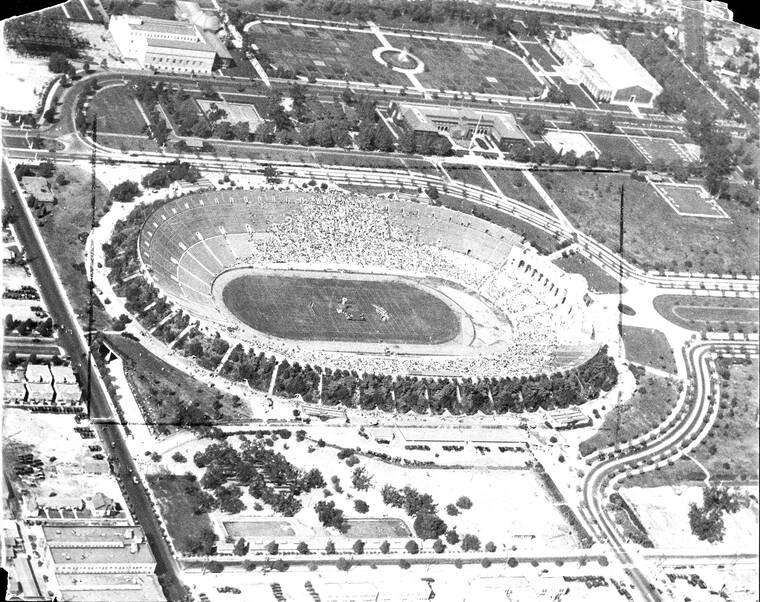Coliseum turns 100: Timeless Los Angeles cultural centerpiece endures as an icon
LOS ANGELES — Bombers droned across the night sky as soldiers scrambled onto the beachhead, taking cover behind huts and clusters of palm trees. The darkness soon erupted with machine-gun fire, thudding bazookas and something else.
Cheering from the stands.
ADVERTISING
In the midst of World War II, U.S. military leaders enlisted Hollywood set designers to create a South Pacific island on the field at the Coliseum. Hoping to boost home-front morale, they staged a mock battle for thousands of spectators, many of whom were defense factory workers. A general told the crowd that victory would not be possible “without the great work done in the plants of this Los Angeles area.”
It made sense to deliver this message at the city’s iconic stadium.
As the Coliseum turns 100 this month, it is natural to think of college football games and the Summer Olympics, but this historic landmark embodies so much more.
Civic leaders built it in the early 1920s as a point of convergence for a burgeoning metropolis. When John F. Kennedy and Martin Luther King Jr. and Nelson Mandela wanted to speak to Southern California, they came to the Coliseum. Same with evangelist Billy Graham and Pope John Paul II.
Roy Rogers held a star-studded rodeo. Evel Knievel jumped his motorcycle over a row of cars. Bruce Springsteen and the Rolling Stones performed for massive audiences and a porn director once duped stadium management into letting him film sex scenes on the field.
The Coliseum has served as “a public space for all kinds of things,” says William Deverell, director of the Huntington-USC Institute on California and the West. “It’s a venerable spot in a city that needed a place for civic culture to happen.”
The stadium’s origins date to the turn of the 20th century and a patch of land known as Agricultural Park, an aging fairgrounds gone to seed. Saloons, brothels and gambling dens sprung up there. A small track held races with horses, camels and dogs in a manner described as “demoralizing in the extreme.”
Faculty and administrators at adjacent USC seethed.
“This is a plague spot, infecting the entire community,” complained William Miller Bowen, a former City Councilman who taught law classes. He worried that “if left alone it will bring us all into ill repute.”
City and county officials agreed to revitalize the property with a rose garden, museum and exposition hall, rechristening it as Exposition Park. Next came a project whose audacity suited the boosterism of the era — a 75,000-seat stadium for a city whose population barely exceeded 500,000.
When voters rejected a bond measure to fund construction, wealthy businessmen — including Los Angeles Times publisher Harry Chandler — procured nearly $1 million in bank loans, with the city and county promising to rent the venue back until the money was repaid.
Construction began in late 1921, guided by John and Donald Parkinson, the father-son architects who later collaborated on such L.A. landmarks as City Hall and Union Station. Their Moderne vision blended Egyptian, Mediterranean Revival and Spanish styles into an immense elliptical bowl with a peristyle court at its eastern end.
This wasn’t like Yankee Stadium, built for just one team. Or Lambeau Field, dedicated to the Green Bay Packers.
“It was meant as a monument to the city,” says Frank Guridy, a Columbia University history professor who studies the civic impact of stadiums. “And it happened at the right moment.”
L.A. hungered to emerge from the shadow of neighboring San Francisco, to position itself as a place of national, even global import. The year 1923 was critical, marking the debut of not only the Coliseum but also the Hollywood sign, the Biltmore Hotel and Disney Brothers Cartoon Studio.
The stadium played a role in fostering the USC-Notre Dame football rivalry and securing a bid for the 1932 Summer Olympics. It hosted an anniversary celebration for the Monroe Doctrine and a Buster Keaton film screening.
Anything to get noticed.
“L.A. wants to be a big-time city,” says Steven Riess, a retired history professor from Northeastern Illinois University who has written about the stadium’s origins. “It’s not just the movie industry — now they have the Coliseum.”
An estimated crowd of 200,000 Angelenos greeted Charles Lindbergh as he climbed out of the “Spirit of St. Louis” at a small airfield east of downtown. Civic leaders had a car, draped in flowers, waiting for him.
Making a splash in 1927 meant being part of Lindbergh’s victory tour as the young pilot buzzed from city to city after his historic transatlantic flight. His parade through L.A. culminated at the Coliseum, where 60,000 spectators gathered.
It didn’t matter that Lindbergh’s speech was fairly pedestrian — a few hundred words urging the city to build a municipal airport. His appearance was a big deal.
“It was the greatest show Southern California has ever known,” The Times reported in a front-page story, adding that “old men danced and flung their hats into the air in an abandon of joy, as women wept and those in between shrieked and cheered and roared.”
Within a few years, as the city’s population reached 1 million, the stadium scored another win, hosting the 1932 Summer Games amid the Great Depression.
“Countries from all over the world sent teams,” Riess says. “L.A. was identified as a world-class city.”
Not that every attempt at making headlines was a success. In 1938, workers constructed an immense wooden ramp that rose from the field, curving 300 feet upward, reaching past the top row of seats. Five specialized machines began pumping hundreds of tons of artificial snow.
The Southern California Open Ski Jump was billed as the first time the wintry European sport would take place in L.A. But rain clouds blew in, flooding streets and turning the runway to mush, forcing a two-day postponement. When the competition got underway on a Tuesday night, a slick surface caused the first jumper to slip halfway down.
“He toppled something like 150 feet,” The Times reported, “and was bloody and unconscious when aid arrived.”
Still, as city, county and state officials eventually assumed control of the stadium, they continued taking chances. The Coliseum Commission booked circuses, a rally for Pres. Franklin D. Roosevelt and Rogers’ rodeo, a very Hollywood affair with Hoot Gibson and Wild Bill Elliott.
Decades later, Knievel’s show featured the “world’s richest” demolition derby with a Rolls Royce and Lincoln Continental smashing into each other. His motorcycle jump over a low pyramid of 50 cars looked almost too easy, prompting grumbles in the stands. He said: “Did they come to see me die?”
It turned out the Coliseum was more than just a geographical midpoint for a metropolis grown willy-nilly in every direction. It was a place where all sorts of people might walk through the gates.
Sports fans came for USC and UCLA football games, as well as a few seasons of baseball on an oddly-shaped field as the newly-arrived Dodgers waited for their ballpark to be constructed in Chavez Ravine.
A million or so people flocked to Graham’s 25-day crusade at the stadium in 1963. The evangelist came to L.A. — with a 5,000-member choir — in hopes of reaching “thousands of misfits” he feared were “trying to escape from the responsibilities of life through alcohol, sex, amusements and materialism.”
Another sort of crowd gathered for King’s 1968 memorial, a tense affair that included African American pastors, labor leader Cesar Chavez, union officials and Black nationalists in dark sunglasses.
“Most cities had a downtown as their center,” Riess says. “That was never the case with Los Angeles.”





